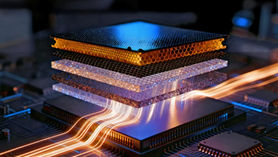Surrounding fields of invisible spectrum radiation - the basis of Neutrinovoltaic technology
- https://www.nanonewsnet.ru
- Jul 9, 2022
- 5 min read
Updated: Sep 24, 2022
In the context of the escalation of the international situation, the priority attention of politicians of all states is focused not only on resolving issues of state security and sovereignty, but also, in particular, on ensuring the “viability” of the energy sector as the basis of the state economy.
In the process of searching for alternative opportunities for energy generation, scientists are moving towards the creation of fundamentally new technologies that are not related to the use of fossil fuels and traditional types of "green" energy, such as Neutrinovoltaic technology.
In connection with the extensive discussion of recent months on the pages of the world press and emerging questions about the Neutrinovoltaic power generation technology created by the Neutrino Energy Group, the president of the company Holger Thorsten Schubart answers the questions that arise.

You named your technology Neutrinovoltaic, which is very similar to Photovoltaic. Is the principle of operation the same as that of solar panels or is it different?
Schubart. Photovoltaic is the generation of electric current from particles of the visible radiation spectrum, which is known to everyone as sunlight, and Neutrinovoltaic is the generation of electric current from particles of the invisible radiation spectrum, known as cosmic neutrinos and, first of all, solar neutrinos.
The similarity of technologies lies in the fact that there is a working surface that perceives radiation, and in this case, a directed movement of electrons occurs, i.e. electricity. However, there is also a fundamental difference:
• The principle of operation of the solar panel lies in the effect of semiconductors, which is silicon. When light hits a photocell (upper silicon plate of the converter unit), electrons are released from the silicon atoms, after which they are captured by the atoms of the lower plate. According to the laws of physics, electrons tend to return to their original position. Accordingly, from the bottom plate, the electrons move along the conductors (connecting wires), giving their energy to charge the batteries and returning to the top plate. Photovoltaic is the conversion of sunlight into electrical current through the concept of the photovoltaic effect.
• The working material of the surface of the base elements of Neutrinovoltaic technology consists of a multilayer material in which alternating layers of graphene and silicon are combined with the addition of alloying elements. Experimentally, we have obtained the result that it is necessary to use a structure consisting of 10 to 20 "silicon-graphene" layers, optimally - 12 layers. The total thickness of such a nanomaterial should preferably be between 0.05 mm and 1 mm. The ratio of graphene (75%) and silicon (25%) is most optimal in the nanomaterial. Layers of graphene and silicon are deposited on a thin metal foil. Graphene has a hexagonal crystal lattice and is a 2D material, but behaves like a 3D material. Due to the property of the crystal lattice, "graphene waves" appear on the surface of graphene. The explanation for the occurrence of "graphene waves" is that neighboring regions alternate between concave and convex curvature. The stronger the influence of neutrinos, temperature and other radiation fields, the stronger the oscillations of graphene atoms, and hence the frequency and amplitude of the oscillations of "graphene waves". Theoretical studies provide an explanation that the source of this process is the electron-phonon coupling, since it suppresses the long-wavelength bending rigidity and enhances out-of-plane fluctuations. Modern microscopes with high resolution allow you to see the "waves" of graphene.
And it is this property of graphene that allowed us to create an ultra-dense, highly sensitive multilayer nanomaterial from alternating layers of graphene and doped silicon. Any radiation fields, including cosmic neutrinos, affect the frequency and amplitude of vibrations of graphene atoms, turning them into resonance. Atomic oscillations at resonance make it possible to enhance the recoil of graphene electrons upon contact with doped silicon. The alternation of layers of “pure”, practically free of impurities of graphene and silicon with the addition of alloying elements leads to an effect that physicists call “oblique scattering”, when electron clouds deviate their movement in one direction, i.e. there is a constant electric current.

I have repeatedly come across the fact that many people know that neutrinos have super penetrating power, and therefore they immediately enter into heated discussions on the topic that there can be no technology that would allow converting neutrino energy into electric current.
Schubart. This is not news to me. Luckily, I'm much less likely to come across this kind of reasoning now. Literally 10 years ago, when I was just starting to talk about Neutrinovoltaic, I was considered, to put it mildly, a dreamer. There was even a whole series of publications in the press with accusations of trying to deceive the general public, journalists and investors. All the counterarguments of my opponents were based on the assertion that the neutrino has no mass and for this reason our development is pure deception for naive citizens and gullible investors. But the year 2015 came, and the Nobel Prize in Physics was awarded for proving that neutrinos have mass. But, if the neutrino has mass, then the neutrino must interact with matter. In 2017, publications of the COHERENT collaboration at the Oak Ridge National Laboratory (USA) appeared, where an experiment was described to detect elastic coherent scattering of neutrinos on the nuclei of argon atoms, which proves the interaction of neutrinos with the nuclei of atoms of substances. A neutrino with mass hits the nucleus of a graphene atom and causes the graphene atoms to vibrate.
Another very important addition. When we talk about Neutrinovoltaic and neutrino current sources, this does not mean at all that the nanomaterial converts only neutrino energy. There is also thermal Brownian motion, as well as other radiation fields that also affect the vibrations of graphene atoms. Everything that can affect the frequency and amplitude of vibrations of graphene atoms, including thermal effects, is converted by our nanomaterial into direct current. It is the thermal effect that we take into account when designing current sources for electric vehicles. Everyone knows how the car body heats up in the summer months in the sun, so we plan to place our current sources not only inside the electric car body, but also under the hood and trunk, as well as to make the entire car body from a special metamaterial capable of converting both invisible spectrum radiation, as well as thermal effects.
As I understand it, the possibility of power generation through the use of a nanomaterial created by Neutrino Energy Group is determined by the properties of graphene, namely, the phenomenon of increased vibrations of graphene atoms?
Schubart. Studies of the properties of graphene carried out in recent years show that graphene is a very hard material. In the material we created, the number of graphene layers is between 10-20. The total neutrino flux through 1 cm2 of the earth's surface is 60 billion neutrinos/sec. Massive neutrinos affect the frequency and amplitude of the graphene wave oscillations, translating them into the resonance of atomic oscillations, but it is very important to understand that only a small part of the energy is transferred, and we are not talking about absorbing or trapping neutrinos. It is the penetrating ability of neutrinos that allowed us to place energy plates in a stack, like a stack of paper, so neutrino current sources are very compact and their overall dimensions make it possible to place them even inside electrical appliances.
Do you know other scientific centers that also deal with the use of graphene for power generation?
Schubart. As research on the properties of graphene deepens, many research centers are beginning to develop work in this direction, for example, the Massachusetts Institute of Technology (MIT). But, admittedly, we are the world leader in the use of graphene for power generation and are way ahead of the competition in its practical applications.
Currently, we are witnessing a new round of scientific and technological revolution in the world. What was considered science fiction only yesterday is already becoming a possible and proven reality today.
Author: Rumyantsev L.K., Ph.D.





















































Comments